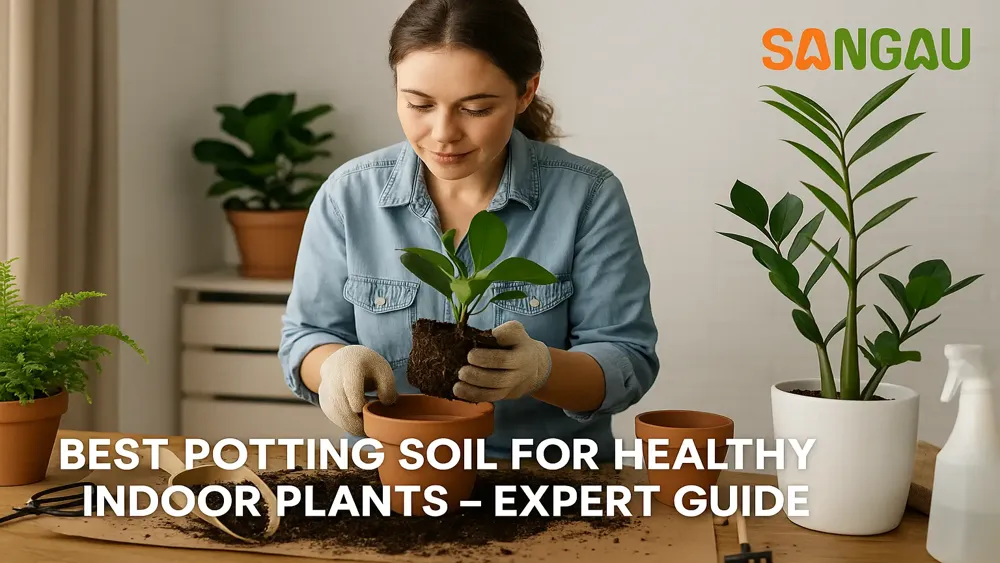Best Potting Soil for Healthy Indoor Plants - Expert Guide
Published : 24 Jun 2025

Best Potting Soil for Healthy Indoor Plants - Expert Guide
Introduction
Indoor plants bring life and beauty to any space, but their growth and health largely depend on the quality of potting soil used. The right soil provides essential nutrients, ensures proper drainage, and allows air circulation around the roots. Using the wrong soil can lead to stunted growth, water retention issues, or even root rot. In this guide, we’ll explore everything you need to know about selecting the perfect potting soil for your indoor plants.
Why Potting Soil Matters for Indoor Plants
Potting soil is more than just dirt—it’s a specially formulated blend designed to meet the needs of potted plants. Unlike garden soil, which can be dense and compact, potting mix is lightweight, ensuring proper aeration and drainage. This is crucial for indoor plants, which rely on a stable growing medium that provides nutrients while preventing water from accumulating around the roots.
Types of Potting Soil and Their Uses
There are different types of potting soil, each catering to specific plant needs. All-purpose potting mix is the most common option and works well for a variety of houseplants. It typically contains peat moss, perlite, and bark to ensure proper drainage. Succulents and cacti require a fast-draining soil mix that prevents water from sitting at the roots, reducing the risk of rot. Orchids, on the other hand, thrive in a bark-based mix that mimics their natural growing conditions. Understanding these differences helps in selecting the best soil for each plant type.
Drainage and Aeration: Essential for Root Health
Good drainage and aeration are key factors in potting soil selection. Plants such as ferns and peace lilies need moisture-retentive soil, whereas succulents and cacti require soil that drains quickly. Well-aerated soil prevents waterlogging, ensuring that roots receive adequate oxygen. Without proper airflow, plants can suffer from root rot, leading to yellowing leaves and eventual decline.
Matching Soil to Your Indoor Plant’s Needs
Each plant species has different soil requirements. Moisture-loving plants like ferns and pothos thrive in rich, organic soil that holds water, whereas plants such as snake plants and aloe vera prefer well-draining soil to prevent excess moisture buildup. Researching your plant’s natural habitat can guide you in choosing the best soil mix, ensuring optimal growth and longevity.
Enhancing Potting Soil with Additives
Standard potting mixes can be improved with amendments to suit specific plant needs. Compost enriches the soil with nutrients, while perlite and sand improve drainage for plants prone to root rot. For plants needing moisture retention, vermiculite is a great addition as it helps regulate water absorption. These customizations allow you to create the perfect growing medium for your indoor plants.
Signs That Your Potting Soil Needs Replacing
Over time, even high-quality potting soil can lose its effectiveness. Compacted soil restricts root growth and reduces water absorption, leading to poor plant health. If water sits on the surface instead of draining or if your plant shows signs of yellowing or wilting despite proper care, it may be time to refresh the soil. Root rot is another warning sign that your potting mix may not be draining well.
When and How to Repot Indoor Plants
Repotting is essential for maintaining plant health, as soil loses nutrients over time. Most plants benefit from fresh soil every one to two years. If roots begin circling the bottom of the pot or pushing through drainage holes, it’s time to move to a larger pot with fresh potting mix. When repotting, remove as much old soil as possible and replace it with nutrient-rich, well-draining soil to give your plant a healthy start.
How Light, Temperature, and Humidity Affect Soil Choice
Indoor environments vary in light exposure, temperature, and humidity, all of which influence soil selection. Plants in low-light conditions may require soil that retains moisture longer, as they dry out more slowly. In contrast, plants in high-temperature or dry indoor climates may benefit from soil with added moisture-retaining materials. Adjusting your soil mix based on environmental factors ensures plants receive the right balance of water and nutrients.
Fertilising Your Potting Soil for Healthy Growth
While potting soil provides initial nutrients, plants eventually deplete these over time. Regular fertilisation replenishes essential nutrients like nitrogen, phosphorus, and potassium. Organic fertilisers, liquid plant food, and slow-release granules are excellent options to keep your plants thriving. Fertilisation schedules vary by plant type, but regular feeding ensures consistent growth and vibrant foliage.
Understanding and Adjusting Soil pH
Soil pH affects nutrient absorption, influencing plant health. Most indoor plants thrive in slightly acidic to neutral soil. Some, like African violets, prefer more acidic soil, while succulents do better in alkaline conditions. A soil pH testing kit can help you determine whether adjustments are needed. If the soil is too acidic, adding lime can help balance it, while sulfur can lower overly alkaline soil to better suit your plant’s needs.
Hashtags
#PottingSoil #IndoorGardening #PlantCare #HealthyPlants #SANGAU


